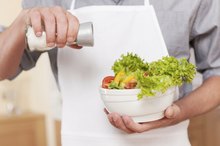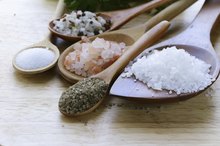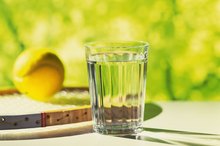Can Eating Salt Prevent Weight Loss?
Your body needs sodium to maintain the balance of fluid in your body, influence muscle contraction and relaxation and transmit nerve impulses. It’s easy to think of salt and sodium as being the same, but they’re not. Table salt is 40 percent sodium and 60 percent chloride, according to the Colorado State University Extension. However, salt becomes a detriment to a healthy diet when you eat more than your body needs.
Why Less is Better
Sodium attracts and holds water. As a result, excess sodium in the body causes fluid retention and increases blood volume, the latter of which makes your heart work harder to move blood through the vessels and increases arterial pressure. This can lead to heart disease, stroke or high blood pressure.
Sodium and Weight Loss
How Many Milligrams of Sodium Should I Have in One Day?
Learn More
Salt will not stop weight loss, but it can stall it. Sodium makes your body retain water. When you eat too much salt, you may see the scale go up a few pounds. Conversely, when you significantly reduce salt intake, you’ll lose a few pounds as your body expels the water it was retaining. The weight you lose, however, is regained once you resume eating foods with salt.
How Much is Enough?
On average, Americans consume more sodium than they need, to the tune of 3,436 milligrams per day. One teaspoon of table salt contains 2,325 milligrams of sodium. Don't consume any more than 2,300 milligrams of sodium per day; 1,500 milligrams if you have diabetes, kidney disease or high blood pressure, are of African descent, or you're middle-aged or older.
Watching Sodium Intake
Is Sodium Bad for Weight Loss?
Learn More
If you’re trying to lose weight, avoid eating processed and pre-packaged foods, which are usually high in salt and sodium additives. You also want to watch your use of condiments, like soy sauce, mustard, ketchup or salad dressing. Use herbs and spices to flavor your food instead of salt. Be careful with salt substitutes. Salt substitutes contain a mixture of table salt and other compounds, and you may be tempted to use too much.
Start Reading Labels
Paying attention to food labels goes a long way toward helping you watch your salt intake. You want to stick to products labeled as “sodium-free,” “very-low sodium,” “low sodium,” “reduced sodium,” “unsalted,” “no salt added” or “without added salt.” Select foods naturally low in sodium, including fruits, vegetables, legumes and unsalted nuts
Related Articles
References
Writer Bio
Connie Peete is a writer specializing in personal finance and health topics. She holds an associate's degree in secretarial science and information processing from the Bryant & Stratton Business Institute.








